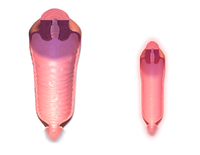
Photo from wikipedia
The Food and Drug Administration recommends against washing raw chicken due to the risk of transferring dangerous food-borne pathogens through splashed drops of water. Many cooks continue to wash raw… Click to show full abstract
The Food and Drug Administration recommends against washing raw chicken due to the risk of transferring dangerous food-borne pathogens through splashed drops of water. Many cooks continue to wash raw chicken despite this warning, however, and there is a lack of scientific research assessing the extent of microbial transmission in splashed droplets. Here, we use large agar plates to confirm that bacteria can be transferred from the surface of raw chicken through splashing. We also identify and create a phylogenetic tree of the bacteria present on the chicken and the bacteria transferred during splashing. While no food-borne pathogens were identified, we note that organisms in the same genera as pathogens were transferred from the chicken surface through these droplets. Additionally, we show that faucet height, flow type, and surface stiffness play a role in splash height and distance. Using high-speed imaging to explore splashing causes, we find that increasing faucet height leads to a flow instability that can increase splashing. Furthermore, splashing from soft materials such as chicken can create a divot in the surface, leading to splashing under flow conditions that would not splash on a curved, hard surface. Thus, we conclude that washing raw chicken does risk pathogen transfer and cross-contamination through droplet ejection, and that changing washing conditions can increase or decrease the risk of splashing.
Journal Title: Physics of fluids
Year Published: 2022
Link to full text (if available)
Share on Social Media: Sign Up to like & get
recommendations!